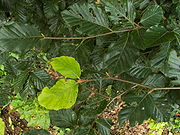Mutation
![]()
The title of this article is ambiguous. For other meanings, see Mutation (disambiguation).
In biology, mutation (lat. mutare "to change/alter, transform") refers to a spontaneously occurring, permanent change in the genetic material. The change initially affects the genetic material of only one cell, but is passed on to its daughter cells. In multicellular animals, a distinction is made between germline mutations, which can be passed on to offspring by inheritance, and mutations in somatic cells, which are not present in the germ cells (gametes) but only in the other tissues of the body. An organism with a new trait resulting from mutation is called a mutant or mutant.
A mutation may or may not have an effect on the characteristics of an organism (silent mutation). Deviating trait expressions may have negative, positive or no consequences at all with regard to viability and/or reproductive capacity. If a mutation expresses itself as a clearly different phenotype, a certain proportion of which (more than 1%) remains stable in a population, this is known in biology as polymorphism. Polymorphism is an essential prerequisite for the emergence of new species (biodiversity).
Sometimes the unexpected phenotypic occurrence of very rare recessive hereditary traits passed on from inconspicuous heterozygous ancestors (as conductors) to the common offspring is mistaken for a mutation.
True mutations can occur spontaneously (stochastic) or be caused by external influences, such as mutagenic radiation (e.g.:UV radiation, ionising radiation) or mutagenic chemicals (mutagens).
In classical cytogenetics, mutations are classified according to their extent: Genomic mutations are changes in the number of chromosomes, chromosomal mutations are changes in chromosome structure that can be detected by light microscopy on chromosome preparations. Gene mutations, on the other hand, cannot be seen microscopically on such preparations and can only be detected by DNA analysis. A gene mutation can consist of the creation of new nucleotide sequences or the loss of previously existing genetic information, or both.
Mutations in genes whose gene products are required for the maintenance of intact DNA, for example tumour suppressor genes, can result in further mutations (mutator phenotype).
The term mutation was coined by the botanist Hugo de Vries in 1901.

Red tulip with half yellow petal due to a mutation
The reddish leaf colour of the copper beech (above) is the result of a mutation in a copper beech (below).
_-blue_mutation_on_perch.jpg)
Blue mutant of the green collared parakeet in the wild (Psittacula krameri)
Types of mutation
differentiation according to heredity
Germline mutations
are mutations that are inherited by the offspring via the germ line; they affect oocytes or sperm and their precursors before and during oogenesis or spermatogenesis. These mutations play a significant role in evolution because they are transmissible from one generation to the next. Germline mutations usually have no direct effect on the organism in which they take place.
Somatic mutations
are mutations that affect somatic cells. They affect the organism in which they take place, but are not inherited by the offspring. Among other things, normal somatic cells can transform into cancer cells that proliferate unchecked. Somatic mutations also play a role in the ageing of an organism. They are therefore important for medicine.
Differentiation according to cause
Spontaneous mutations
are mutations without any particular external cause, such as the chemical decay of a nucleotide (e.g. cytosine can become uracil through spontaneous deamination) or the tunnel effect (proton tunnelling in DNA).
Induced mutations
are mutations caused by mutagens (mutation-inducing substances or radiation).
Differentiation according to mechanism
Replication error
DNA polymerases build a complementary DNA strand according to template with different high error rates.
Insufficient proof reading activity
Some DNA polymerases have the ability to detect and correct misincorporations independently (proof-reading). However, the DNA polymerase α of eukaryotes, for example, has no proof-reading activity.
Defects in pre- and post-replicative repair mechanisms
When an unusual nucleotide, such as uracil, is found in the DNA, it is removed. In the case of a mismatch between two DNA-typical nucleotides, the repair enzyme makes a decision with a 50 percent probability of error.
Uneven crossing-over
Mismatches in meiosis can occur due to adjacent similar or identical sequences on the strand, such as satellite DNA or transposons.
Non-Disjunction
The mis-segregation or non-disjunction of chromosomes leads to incorrect distribution among the daughter cells and thus to trisomies and monosomies.
Integration or escape of transposons or retroviruses
These elements can integrate or disintegrate into genes or gene regulatory regions, thereby altering the amino acid sequence of a protein or the abundance of protein reads.
Differentiation according to size and location of the change
Gene mutation
a hereditary change that affects only one gene. Examples are point and screen mutations. In a point mutation, only one organic base in the genetic code is changed (mutated). However, a frameshift mutation, which is an insertion (insertion) or deletion (deletion) of a number of bases that is not a multiple of three, alters the entire structure of a gene because of the triplet coding in the genetic code and therefore usually has much greater effects. Another possible consequence is alternative splicing. Gene mutations also include deletions of longer sequences as well as gene duplications, in which a specific section of a chromosome doubles or multiplies.
Chromosomal mutation or structural chromosomal aberrations
heritable change in the structure of individual chromosomes. The structure of a chromosome visible under the light microscope is altered. Thus, chromosome pieces can be lost or parts of another chromosome can be incorporated. An example is the catcry syndrome, in which a section of chromosome 5 has been lost. As a result, numerous genes are missing, leading to severe alteration and damage in the phenotype.
Genomic mutation or numerical chromosomal aberration
a change in which entire chromosomes or even sets of chromosomes are increased (aneuploidy, polyploidy) or lost. A well-known example in humans is Down syndrome. Here, chromosome 21 is present in triplicate.
Differentiation according to consequences for the protein
Truncating mutations
Mutations of a genome segment coding for a protein, resulting in a shortened gene product (protein).
Gain-of-function mutations (GOF)
In this case, the gene product (protein) gains activity and is then also called hypermorphic. If the mutation results in a completely new phenotype, then the allele is also referred to as neomorphic. A gain-of-function mutation that produces a visible phenotype is called 'dominant'. However, if a gain-of-function allele shows a phenotype exclusively in the homozygous state, it is called a recessive gain-of-function mutation.
For gain-of-function mutations in viruses and bacteria in vitro, see.
→ Main article: Gain-of-function research
Loss-of-function mutations (LOF)
In this case, the gene product (protein) becomes functionless due to a mutation in the gene. If the loss of function is complete, it is referred to as a null allele or an amorphous allele. If part of the wild-type function remains, it is called a hypomorphic allele.
Loss-of-function mutations are codominant or (usually) recessive if another allele can compensate for the loss of function of a gene.
Haploinsufficient mutations
Loss-of-function mutations in a gene that does not tolerate haploinsufficiency, i.e. in which a halving of the expressed gene dose (mRNA) is already sufficient to cause an altered phenotype. (This only affects diploid organisms with a heterozygous (monoallelic) genotype of the mutation).
Dominant negative mutations
As with loss-of-function mutations, the mutation causes the gene product to lose its function. However, the mutant protein is also able to suppress the function of the remaining second (wild-type) allele, which a mere loss-of-function allele usually does not or cannot do. Many truncating mutations are dominant-negative. (This only affects diploid organisms with a heterozygous (monoallelic) genotype of the mutation).
Differentiation according to consequences for the organism
Neutral mutations
can alter the phenotype, but have no fitness consequences.
Silent mutations
are mutations in which the protein formed remains unchanged. Nevertheless, changes can occur in the organism because the mRNA folds when it leaves the nucleus. In this process, different folding can influence the amount of protein formed.
Conditional-lethal mutations
Mutations whose alteration of the gene product kills an organism only under certain growth conditions.
Lethal mutations
Mutations that, once they occur, kill an organism in any case, regardless of its stage of life.

Sickle cell anaemia is caused by a mutation in the gene of a haemoglobin subunit. It leads to sickle-shaped red blood cells, here together with normal forms.
Mutation frequency
In humans, the number of new mutations (de novo mutations) has been determined by sequencing the DNA of the father, mother and the corresponding child. On average, 45 new mutations were found, with about 80 % of the mutations originating from the father's sperm. Since sperm formation (spermatogenesis) is continuous in males and thus the number of replications of DNA increases with age, it is not surprising that the number of new mutations increases with the age of the father. A young father of 20 contributes 20 mutations, while an older father of 40 contributes 40 mutations. Although the woman's eggs are all formed in embryonic development before birth and thus no further replication of DNA occurs, an increase in new mutations from 7 to 12 was observed in women of 40 compared to women of 20. Obviously, the new mutations do not only occur during the replication of the DNA.
The high frequency of mutations was revealed in a sequence analysis of human protein-coding DNA in 60,706 individuals. The study uncovered 7.4 million variants, which corresponds to an average of one mutation in every eight base pairs of human DNA.
Questions and Answers
Q: What is a mutation in biology?
A: A mutation is a change in the genetic material, either in the DNA or in the chromosomes that carry the DNA.
Q: What are the heritability effects of mutations?
A: Unless they have lethal effects, mutations are heritable and can be passed down to the next generation.
Q: What are the reasons for mutations?
A: Mutations can occur due to errors during meiosis when gametes (eggs and sperm) are produced, or due to damage by radiation or certain chemicals.
Q: Are mutations predictable?
A: Mutations happen randomly and are not predictable.
Q: What is an individual carrying a mutation called?
A: An individual carrying a mutation may be called a mutant or a mutation.
Q: What is the most obviously affected trait by a mutation?
A: The trait or character most obviously affected by a mutation is dependent on the specific mutation in question.
Q: What is the significance of mutations in evolution?
A: Mutations are the ultimate source of genetic variation and are important in driving evolutionary change.
Search within the encyclopedia

